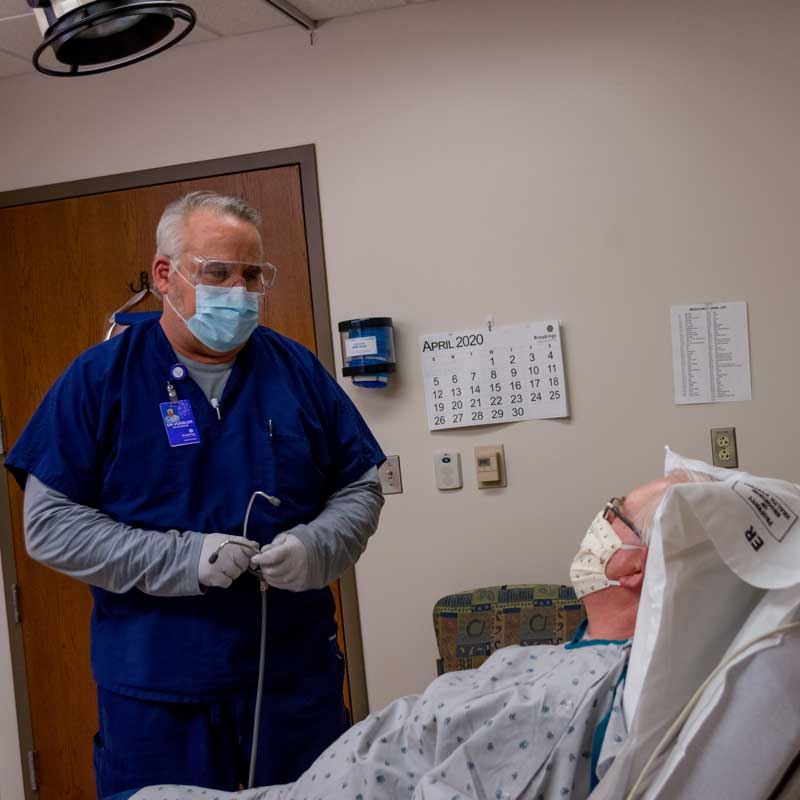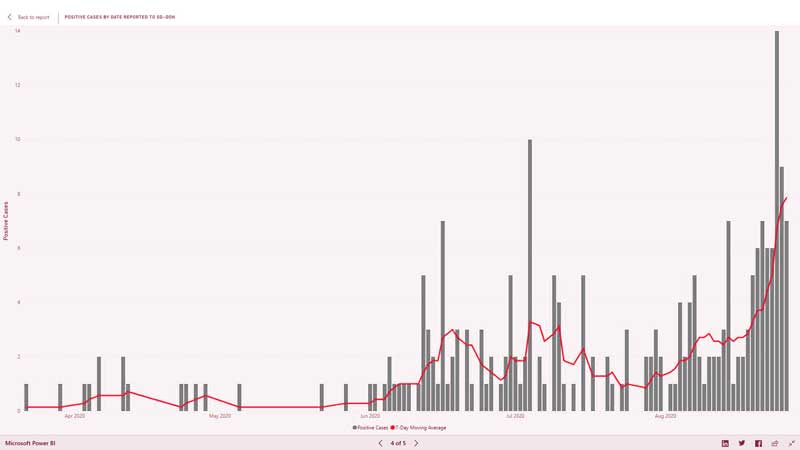Brookings Health Asks for Public’s Help to Stop Recent Virus Wave
- August 27, 2020
Goal to Have County in Minimal to None Community Spread Categories

As the number of COVID-19 positive cases continues to rise in Brookings County and the surrounding area, Brookings Health System asks the public to help stop virus transmission and reduce community spread to the minimal or none category .
“The month of August has had the highest number of cases to date in Brookings County at 110 and we still have some days to go,” said Infection Preventionist Bunny Christie. “We had 46 cases in June and 50 cases in July. All that just goes to show how high the infectivity rate is for this virus. It easily and quickly spreads within a community.”
The South Dakota Department of Health (DOH) has listed Brookings as having moderate spread of COVID-19, meaning the county has 10 -100 active cases per 100,000 people. Substantial spread is listed by the DOH as having over 100 active cases per 100,000 people, something Brookings Health wants the community’s help to avoid.
“Statewide the demographic with the highest number of positives are young people, age 20 – 29 years of age,” said Christie. “Many young adults may feel like they can take the risk because they are young and healthy. However, we do not know the long-term side effects of this virus and how it may affect future health. In addition, studies have shown that asymptomatic and pre-symptomatic people do unwittingly transmit COVID-19 to others. That can make an impact on the most vulnerable in our community, including the elderly and those who are immunocompromised.”
The DOH recently announced university students who test positive for the virus will be counted in the current county of residence. That means if students attending SDSU who live in Brookings test positive for COVID-19, they are reported in Brookings County’s case numbers.

“The rise in positive cases began before students started coming back to the community and classes were in session,” said Christie. “Spreading a disease – just like stopping it – is a group effort. COVID-19 has a high infectivity rate, meaning it easily spreads from person to person. If people don’t do their part – such as hand washing, covering coughs and sneezes, staying six feet apart from one another and wearing a mask – the virus is going to spread like the recent uptick in cases has demonstrated.”
According to the Centers for Disease Control and Prevention (CDC), the COVID-19 virus spreads mainly from person-to-person contact. The virus is primarily carried by respiratory droplets which are formed when an infected person coughs, sneezes or talks. The droplets can land in the mouths or noses, or possibly be inhaled into the lungs, of people within six feet of the infected person.
There is currently no vaccine to prevent COVID-19. Government officials estimate a vaccine will be ready approximately 12 to 18 months from the start of the pandemic, which equates to late spring of 2021. The best prevention for COVID-19 is to avoid exposure to the virus. Infection control precautions to prevent exposure include:
- Practice good respiratory etiquette and hygiene. Cover your coughs and sneezes with a tissue. If a tissue is not available, cough or sneeze in your upper sleeve.
- Avoid touching your eyes, nose and mouth with unwashed hands.
- Wash your hands often with soap and water for at least 20 seconds. If soap and water are not available, use an alcohol-based sanitizer that contains at least 60% alcohol.
- Practice social distancing when out in the community by trying to stay six feet away from other people. Do not hug, kiss, shake hands or make other unnecessary contact.
- Wear a cloth face covering that snugly covers both your mouth and nose in public settings, especially in situations where you may be closer than six feet to people.
- Clean and disinfect high-touch surface areas, such as counters, tabletops, doorknobs, bathroom fixtures, toilets, phones, keyboards, tablets, etc. every day. COVID-19 is easily cleaned by household cleaners or soap and water.
- Monitor your health. Be alert for COVID-19 symptoms and take your temperature if symptoms develop.
- Stay at home if you’re sick and self-isolate to prevent the spread of illness.
According to the CDC, COVID-19 symptoms may appear 2 to 14 days after exposure to the virus. Most people typically experience mild to severe respiratory illness with symptoms of fever, cough and shortness of breath. Other symptoms may include:
- Chills
- Fatigue
- Muscle or body aches
- Headache
- New loss of taste or smell
- Sore throat
- Congestion or runny nose
- Nausea or vomiting
- Diarrhea
“If you experience symptoms, please contact your primary care provider right away,” said Christie. “Testing is available at the local clinics, but please remember to call the clinics first for instructions.”
More information on COVID-19, what the public can do, and how Brookings Health System is responding to the pandemic can be found at brookingshealth.org/COVID.
About Brookings Health System
Brookings Health System, located in Brookings, South Dakota, includes a 49-bed hospital, the 79-bed The Neighborhoods at Brookview nursing home, Brookhaven Estates senior living apartments, Yorkshire Eye Clinic & Optical, and medical clinics in Arlington, White and Volga, South Dakota. It is a non-profit, city-owned facility that offers the community a full range of inpatient, outpatient, emergency and extended care services. Brookings Hospital provides local access to doctors in Brookings and offers robotic da Vinci surgery and Mako robotic-arm assisted procedures, making it one of the premier rural community hospitals in South Dakota. For more information about the services offered at Brookings Health System, please call (605) 696-9000 or visit us on the Web at brookingshealth.org.

